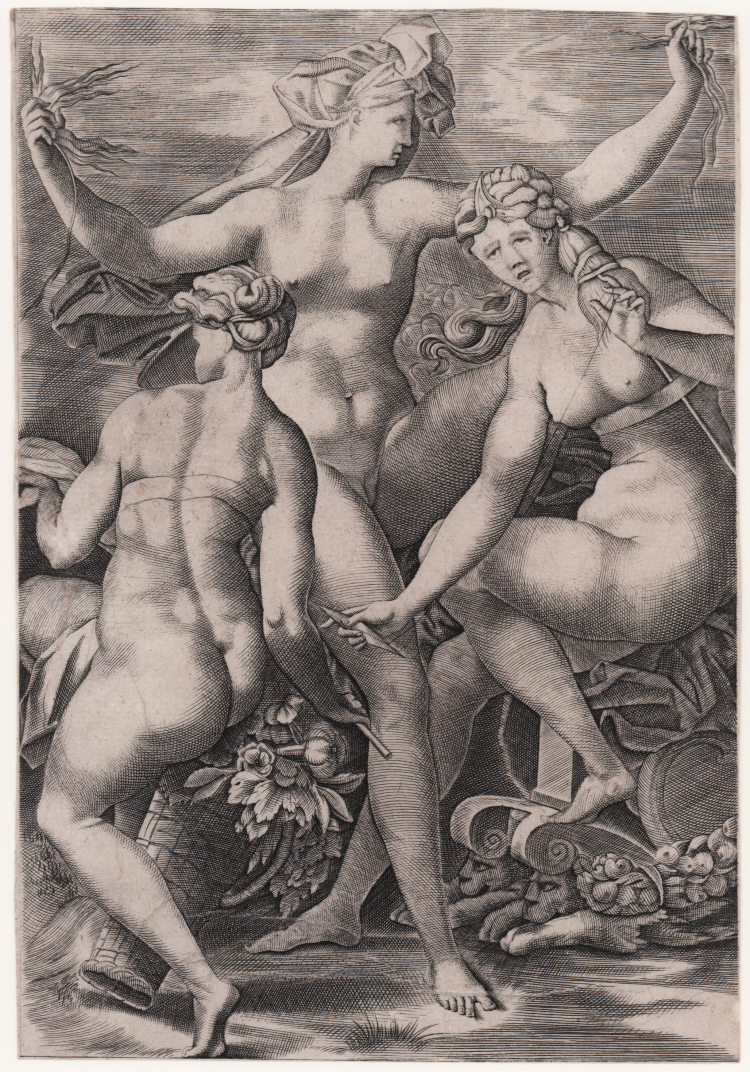




| Reference: | S31776 |
| Author | Renè BOYVIN |
| Year: | 1540 ca. |
| Measures: | 167 x 243 mm |



| Reference: | S31776 |
| Author | Renè BOYVIN |
| Year: | 1540 ca. |
| Measures: | 167 x 243 mm |
Engraving, 1540-45 circa, not signed. After Rosso Fiorentino.
A very good impression, printed on contemporary laid paper, trimmed close to the platemark, some paper folds at bottom left, generally very good condition.
The scene depicts the three Fates: on the right, Lachesis spinning the thread of life from her distaff, on the left Clotho, seen from behind, measuring the thread with a rod, and in the middle, Atropos ripping it apart.
Although this engraving is not inscribed to Rosso, his authorship of its composition has never been questioned.
Dusmenil ascribed the engraving to Renè Boyvin, because the Fate seen from the back is used for the female figure of “Caritas Romana”, attributed to him.
According to the documents published by Metman, the Three Fates would have been engraved by Milan by 1545.
Milan could have worked directly from a drawing by Rosso, or he could have worked from a copy of Rosso’s drawing made especially as a model for the engraver, as in the case of Milan’s Dance of the Dryads.
Being young and nude as well as slender and graceful, these three figures have something of the aspect of the Three Graces, as Van Mander seems to have identified them.
Other details in the picture may also be references to subjects beyond the usual realm of the Fates themselves. Atropos’turban gives her a sibylic aspect. Clotho sits precariously upon a basket of flowers, suggesting Flora or Spring or simply abindance and freshness.
Lachesis wears a crown, and her seat resembles a chariot pulled by lions. These attributes are possibly a reference to Cybele. The sky appears throughout Rosso’s art, especially in the works he produced in France, and they not seem inappropriate here in enlarging upon the meaning of the three Fates.
The Three Fates offer a different level and a different range of significance. Its sexuality is frank but also compelling, because the figures are so grand and so eloquent in their posture and gestures. This eloquence insinuates their sexuality into their identify as the Fates and leads us to experience the tragic consequences indicates by Atropo’s gesture.
|
Zerner 1969 PM.2; Robert-Dumesnil 1835-71 VIII.33.31; Carroll, Rosso Fiorentino, n.105.
|
Renè BOYVIN (Angers 1525 ca. - Roma 1580 ca.)
|
French engraver, etcher and designer. Vasari, in his Vita of Marcantonio Raimondi, mentions that ‘after the death of Rosso [Fiorentino], we saw the arrival from France of all the engravings of his works’. He attributed this upsurge of engraved reproductions ‘to the copperplate engraver René’, that is René Boyvin. He came to Paris c. 1545 from Angers, where he was an associate of the mint. In Paris he might have been in contact with Antonio Fantuzzi, and he is known to have renewed a contract of service with the engraver Pierre Milan in 1549. In 1553 he completed two plates that Milan had failed to finish for the music publisher Guillaume Morlaye (c. 1510–after 1558); one of these was the Nymph of Fontainebleau. He later opened his own workshop, and it is known that Lorenzo Penni, the son of Luca, was working for him in October 1557. Boyvin survived for many years despite the Calvinist beliefs for which he was imprisoned in January 1569. He seems to have published nothing under his own name between 1569 and 1574. His last dated work is from 1580, but it appears that he was still alive well into the 17th century.
|
|
Zerner 1969 PM.2; Robert-Dumesnil 1835-71 VIII.33.31; Carroll, Rosso Fiorentino, n.105.
|
Renè BOYVIN (Angers 1525 ca. - Roma 1580 ca.)
|
French engraver, etcher and designer. Vasari, in his Vita of Marcantonio Raimondi, mentions that ‘after the death of Rosso [Fiorentino], we saw the arrival from France of all the engravings of his works’. He attributed this upsurge of engraved reproductions ‘to the copperplate engraver René’, that is René Boyvin. He came to Paris c. 1545 from Angers, where he was an associate of the mint. In Paris he might have been in contact with Antonio Fantuzzi, and he is known to have renewed a contract of service with the engraver Pierre Milan in 1549. In 1553 he completed two plates that Milan had failed to finish for the music publisher Guillaume Morlaye (c. 1510–after 1558); one of these was the Nymph of Fontainebleau. He later opened his own workshop, and it is known that Lorenzo Penni, the son of Luca, was working for him in October 1557. Boyvin survived for many years despite the Calvinist beliefs for which he was imprisoned in January 1569. He seems to have published nothing under his own name between 1569 and 1574. His last dated work is from 1580, but it appears that he was still alive well into the 17th century.
|